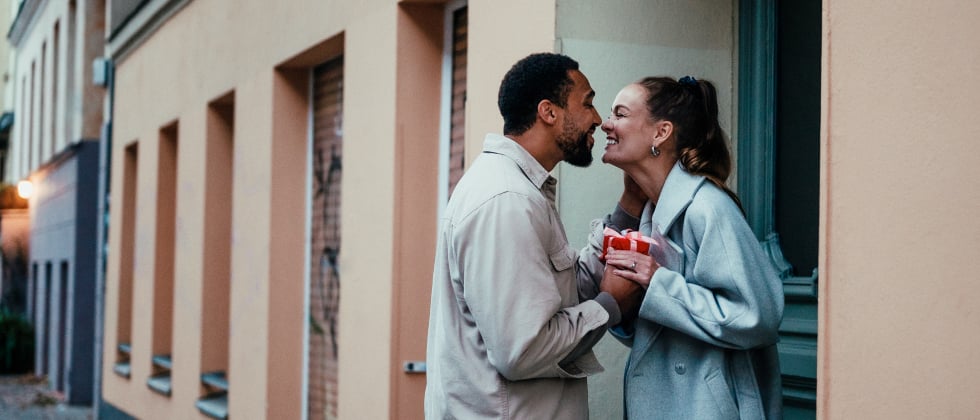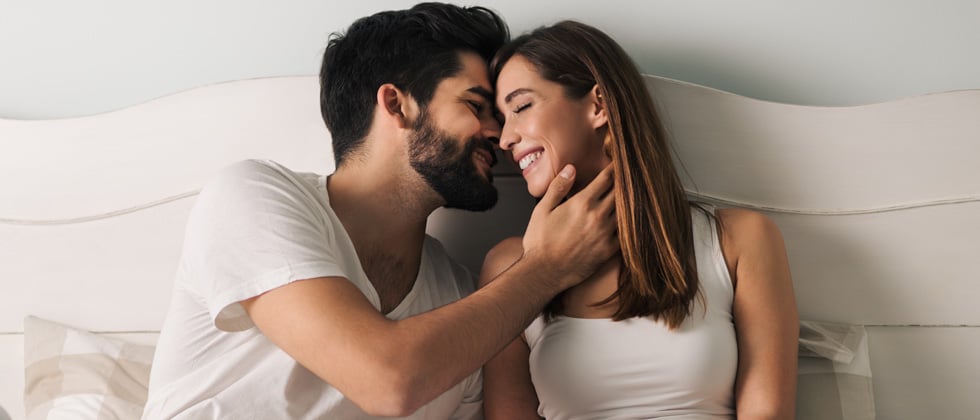
Why do humans kiss: explaining an age-old phenomenon
Why do humans kiss? We can all probably name some iconic kisses – the soldier and the nurse at the end of World War Two, the barrier-shattering smooch between Kirk and Uhura on Star Trek, the couple kissing in front of the Berlin Wall, even the upside-down kiss between Spiderman and MJ – but it’s likely very few of us have thought about the history and culture behind this iconic display of affection. In this article, we’ll answer all the kiss-related questions – why do people kiss on the lips? Why do we like kissing? When was kissing invented?
Table of Contents
Why do we kiss? Because biology tells us to
Why do humans kiss? Perhaps because it feels good. Through the centuries, kisses have been used to demonstrate romantic affection, connect with your partner both sexually and emotionally, and as a way to bond with your partner. It’s also an intimate activity while not being quite as intense as sex, which makes it a great way to make your attraction to your partner clear to them. Plus, it’s just fun, especially if your partner is a good kisser.
Science also backs up the idea that kissing is good for your relationship, not to mention your health. According to a 20191 study, kissing can decrease the amount of cortisol, a hormone linked to stress, in your body. A research study from 20222 shows that affectionate touch such as kissing can have several beneficial effects, such as reducing stress, increasing how satisfied you feel with your life, and improving your perception of your relationship.
Another reason humans kiss is to express sexual desire. Most human beings like sex, and kissing is a great precursor to the main act. In fact, how often you kiss someone is often a good indicator of how enjoyable sex with them is – a 2023 study3 showed that there was a positive correlation between the frequency of kissing and the amount of recent sexual experiences. According to the study’s authors, levels of arousal, orgasms, and event-specific sexual satisfaction all increased when the number of kisses did, meaning that kissing can be a key component of good sex.
Kissing isn’t just about a physical connection, though – especially for people who resonate with physical touch as a love language – kissing can be a great way to connect with partners. Animals of all kinds groom each other to show care and affection – it’s no surprise that humans, having no fur, have found an alternate way to express their affection. Additionally, kissing is a great way to get to know someone better – sexual compatibility is an important consideration for many of us and kissing is a great way to get a sneak peak of what someone is like in bed.
Why do people kiss? It’s a cultural thing
If you’ve ever wondered, ‘why do humans kiss?’ it might blow your mind to know that there are several cultures in which kissing isn’t actually a sign of romantic affection! According to a study of 168 cultures from all over the world, only 46% of them used kisses as a form of romantic affection.4
The study used only one American culture – the Amish, who do kiss each other romantically – in order not to flood the results with American data, instead focusing on people from all over the world. Interestingly, they found that cultures with distinct social classes, like in Japan or Western Europe, do use kissing as a way to express romantic affection, while those that do not, such as the Mehinaku in Brazil, do not.
The study also found that four-fifths of hunter-gatherer cultures do not use lip kisses to express romantic affection, a notable exception being the communities around the Arctic Circle, such as the Inuit. It has been suggested that the limited amount of exposed skin thanks to the region’s biting cold makes lip kissing more acceptable here. Additionally, the researchers found a strong link between how complex societies are and how prevalent lip kissing is, which makes sense – when you have more leisure time, not to mention privacy, you can spend it on kissing your partner rather than hurrying to get to the main act.
There is also some speculation that oral hygiene plays a part in deciding the acceptability of lip kisses, as vanishingly few people find bad breath sexy. Additionally, things like gum disease and herpes can be transmitted via kissing, so it absolutely makes sense that cultures without access to treatment methods would try and limit the spread that way.
Even among cultures that do show romantic affection by kissing each other on the lips, there is a lot of variation. For example, couples from more conservative religious denominations may choose not to kiss until several dates into their relationship, or even until they’re engaged or married. At the other end of the spectrum, at some nightclubs and bars, it’s considered perfectly acceptable to kiss strangers you likely won’t ever see again once the night is done. Your culture can also affect how comfortable you are kissing in public – more conservative couples might choose to only kiss each other on the lips in private even once they’re engaged or married.
Why do we kiss on the lips?
Our lips, with all their nerve endings, are some of the most sensitive parts of our bodies. Pressing them against another pair of lips just feels good. While scientists have tried, for years, to find an answer to the question, ‘why do we like kissing?’ the answer may simply be rooted in the most basic desire of all – pleasure. We’ll talk more about the specific ways in which kissing is pleasurable in the next section, but it’s clear that in many cultures, sharing lip kisses is a deeply ingrained sign of romantic affection and has been for centuries, if not millennia. Amazingly, evidence has been found of lip kissing as a way to show romantic affection as far back as 2500 B.C.E.5
While not all human cultures care to kiss each other on the lips as a show of romantic love, some of our closest cousins on the evolutionary scale do. While bonobos are not our direct ancestors, they are very closely related to us. Bonobos have been frequently observed kissing mates on the lips.
Some biologists claim our habit of using kissing to show affection comes from our chimpanzee ancestors’ habits of partially chewing food before feeding it to their young. This display of maternal affection evolved in some cultures into the display of romantic love we are familiar with now.
Additionally, kissing may play a role in how we select our partners. In a September 2007 interview with the BBC, evolutionary psychologist Gordon G. Gallup, Jr., of the University at Albany, State University of New York, said “Kissing involves a very complicated exchange of information—olfactory information, tactile information and postural types of adjustments that may tap into underlying evolved and unconscious mechanisms that enable people to make determinations … about the degree to which they are genetically incompatible.”
While there is no scientific evidence that humans, unlike their plant and animal counterparts, can sense pheromones, some biologists, like Sarah Woodley of Duquesne University, suggest that we might be able to sense pheromones with our noses. Such an ability would certainly make it easier for humans to sense potential mates’ pheromones when they kiss.
Why do we like kissing?
When we kiss each other on the lips, our brains release three very important hormones: oxytocin, serotonin, and dopamine. What are they, and what role do they play in how our brains function?
First, what are hormones? Hormones are chemicals that manage different functions, by carrying messages from your brain to different parts of the body. These messages tell your body what to do and how to do it.
- Oxytocin: Produced by the hypothalamus, oxytocin is a complex hormone with many and varied functions. While its primary role is in childbirth and lactation, it also has a role to play in fostering sexual attraction, building trust and strengthening your romantic attachment to the person you’re kissing.
- Serotonin: Made from the essential amino acid tryptophan, serotonin is a key component of our mental health and happiness. Often called the ‘feel good’ hormone, serotonin plays a major part in keeping you focused, emotionally stable, happy, and calm – to the point where low levels of serotonin are associated with depression. Serotonin also boosts your sexual desire, along with dopamine.
- Dopamine: Made by the adrenal gland, dopamine has a key role to play in many bodily functions. It’s most commonly known as the hormone responsible for quick bursts of pleasure, but it also deals with moods, motivation, arousal, attention, and movement.
Over the course of millions of years of evolution, humans have become hard-wired to seek out sources of oxytocin, serotonin, and dopamine. Dopamine, in particular, has been shown to be almost addictive – it’s why it’s so hard to stop eating junk food, or playing silly games on your phone that give you random rewards. Luckily, kissing also gets you dopamine – and as a bonus, it’s free!
When was kissing invented?
Sadly, we don’t have proof of when the first kiss likely happened, since humanity probably hadn’t invented writing or even cave art yet. The earliest records we do have are in cuneiform – a method of carving letters into clay with a sharp stick – and date back over 4500 years ago, to ancient Sumer.
Since then, artists and writers alike have depicted the kiss in various ways. The Kama Sutra has an entire chapter on kissing, and the Bible, despite its focus on God’s love, does take the time to mention an earthlier kind of affection as well. Several famous pieces of art have depicted kisses over the centuries, from Rodin’s The Kiss and its depiction of lovers embracing, to Gustav Klimt’s far more abstract depiction of a kiss. Reams of poetry and many pages of prose have been dedicated to kisses, by authors from Shakespeare to Beverly Jenkins. And of course, there’s that iconic photo we mentioned earlier, the soldier who swept a nurse into a kiss to celebrate the end of the Second World War.
At least in the West, kissing on the lips has made a slow but steady journey towards respectability. For many centuries, at least in public, locking lips was the preserve of married couples; to be caught with a man’s lips on yours meant ruination for a Regency lady. (The men, of course, suffered no consequences). As time marched on and women fought for, and gained, more rights, they also gained more agency. The sexual revolution of the 1960s marked a turning point, not just for sex, but for kissing as well. Sex – and by extension kissing – became much less taboo.
These days, of course, the only rule when it comes to kissing someone is that all parties involved should enthusiastically consent.
A simple touch with surprising layers
We might think of it as just a touch of lip on lip, but the truth is, ‘why do humans kiss’ is a complex question with many factors – biological, cultural, evolutionary – influencing the answer. Regardless of whether we are conditioned culturally to show romantic affection with a kiss on the lips or not, it can’t be denied that humans – regardless of time, place, or background – will always find some way of bonding with each other. Looking for someone to practice a culturally sanctioned way of showing romantic affection with? At eharmony, we make it easy to find people who share your values and are looking for the same things in a relationship that you are. Sign up for eharmony and take your first steps on the journey to finding real love with someone compatible today.
Your search for a great relationship has never been easier with groundbreaking overhaul of the eharmony you know and trust.
We regularly review and update our articles to incorporate the latest research, expert insights, and study findings, ensuring you receive the most relevant information. Learn more about our editorial process.
- Current Version
-
-
Written by
eharmony Editorial Team -
Editorially reviewed by
Copy Editors -
Editorial quality review by
eharmony Editorial Team
-
Written by










